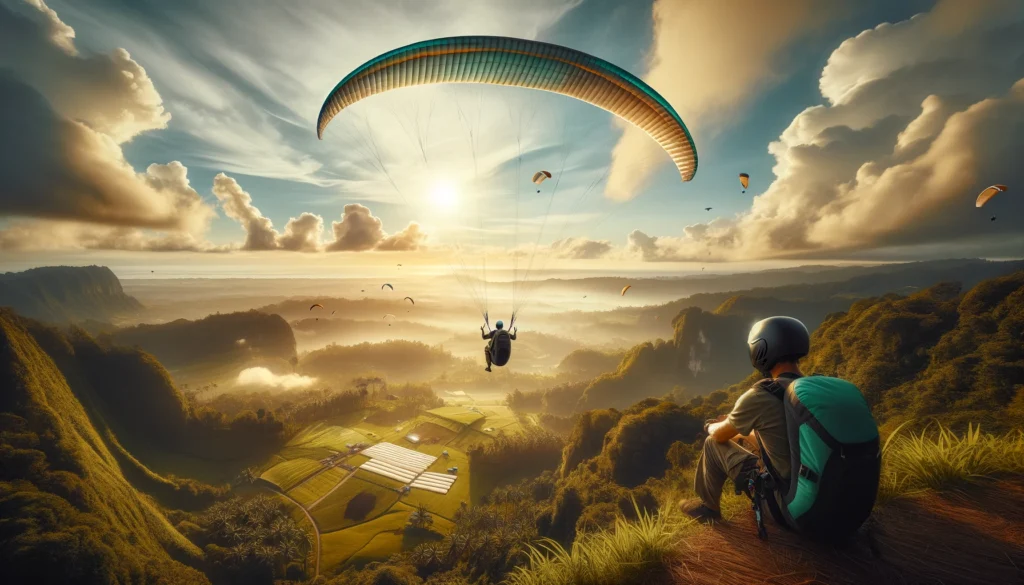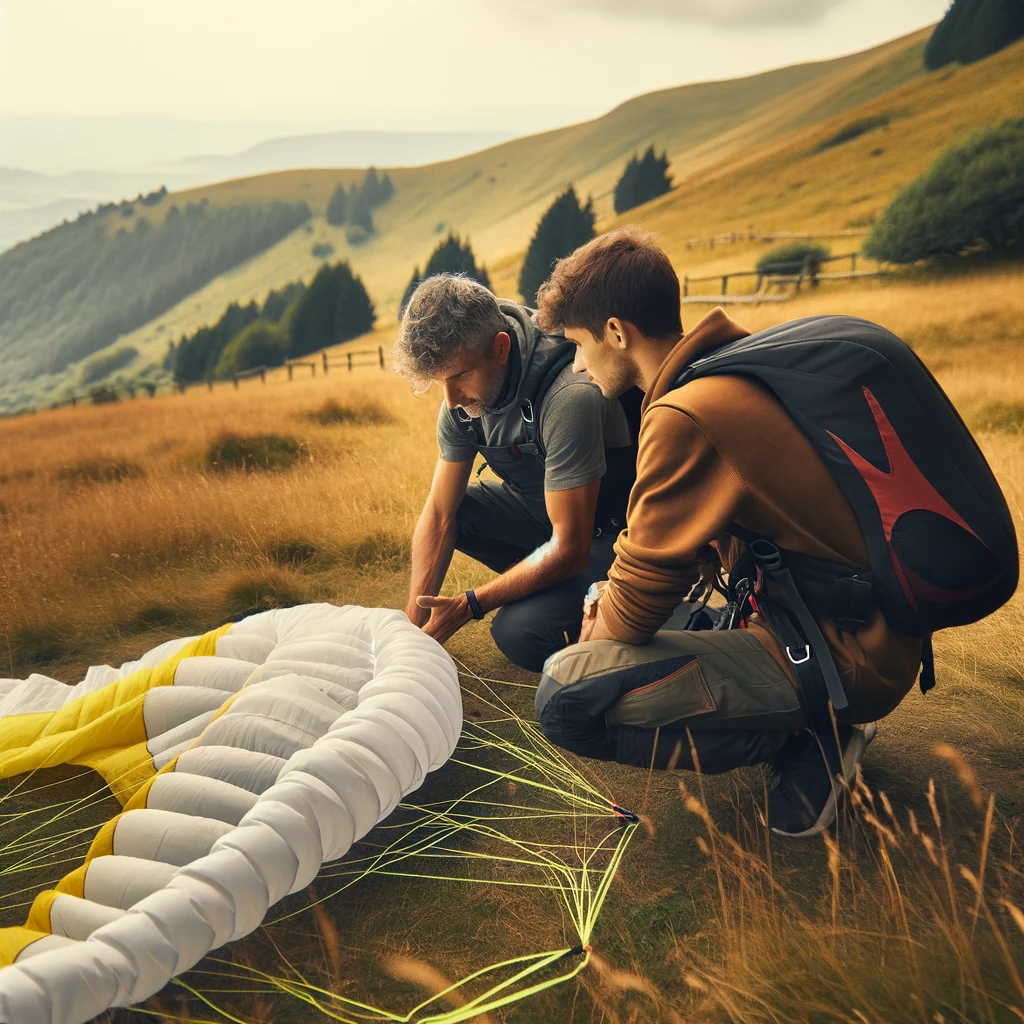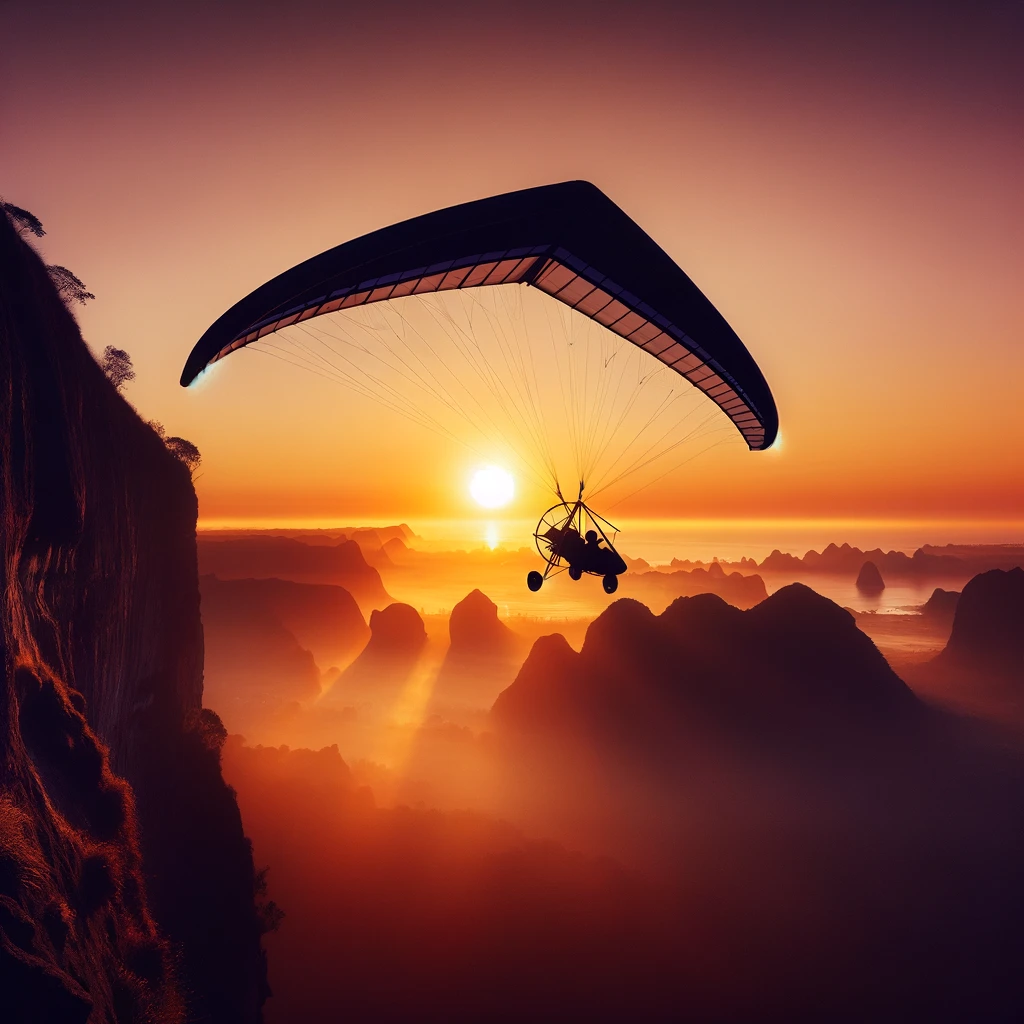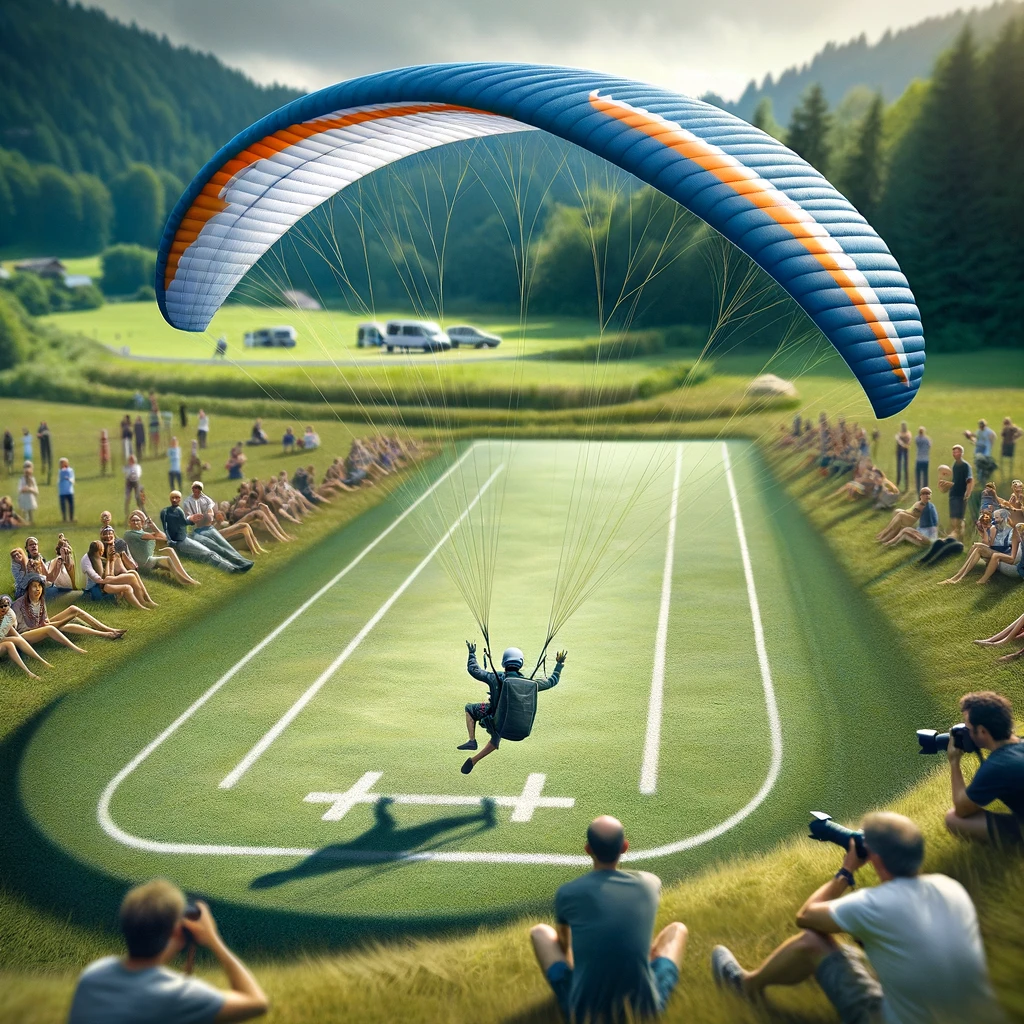What is Paragliding:
Paragliding is a thrilling sport that enables you to mimic the flight of a bird. It provides the adrenaline of skydiving along with the refinement of flying. You will clip on a harness and tie it to the wing, which looks like a giant parachute.
Contrary to this, you do not fall but float with the airflow. It is easy to start because you don’t need much equipment. It’s notable for adventurers and enthusiasts, who love flying across the skies.
In Paragliding you will take off from a hill, or a winch will lift you if the surface is flat. After a moment, you are steering into the air, whether you are a newbie or a professional, everyone is welcome here. But first, the people involved in paragliding should get proper training about it & follow some rules, which we will also assist further on.
Safety is important, and you can ensure this through the fact that expert instructors teach you and ensure each flight is safe and enjoyable. So in this article, we are going to discuss all about Paragliding, types of paragliders like motor power paragliders, and Hang Gliding vs Paragliding comparison, to know which is better. Also, get our hands on paragliding old cousin Parasailing & safety measures of each, let start with the traditional paragliders
Is Paragliding Safe?

In the case of paragliding, like other adventure sports, safety mostly depends on the pilot himself and his perspective on the training and weather matters. Paragliding equipment includes many safety features like backup parachutes, helmets, and emergency GPS tracking.
Additionally, having certified instructors provide comprehensive training that helps pilots gain knowledge of weather conditions assessment, flight decision-making, and safe launching and landing.
Despite this, following the safety protocols, having continuous education, and not overflying can significantly reduce the risks. The paragliding community prefers safety first; many clubs and schools highlight the constant learning and the usage of maintained updated gear.
Ensuring Safety in Paragliding:
Furthermore, prioritizing safety ensures a long and enjoyable paragliding career:
- Weather Savvy: The capability of pilots to read and access weather conditions is essential for the safety of the journey.
- Continuous Learning: Similarly, continued training and exercise improve you each time, and you must be alert and practice safety in each of your flights.
- Gear Maintenance: Ensuring that you have your safety equipment in top condition is not negotiable, but an integral part of safety.
- Self-awareness: Eventually, reckoning with your limits and keeping yourself within those limits is more of your insurance against all hazardous uncertainties.
Safety is the critical element that brings about the excitement of paragliding and its continued popularity.
How to Learn Paragliding:

Besides, becoming a skilled paraglider involves several key steps:
- Ground Training: First, you’ll study the down positions and also get command on the grounding of these wings, back to the surface.
- Tandem Flights: Next, an instructor and the trainee will fly together, exercising flying in a real-life scenario. However, the primary objective will be safety.
- Solo Flights: With your skills getting better and better, then you can fly solo. The first step is to be able to glide without the assistance of anyone else.
- Advanced Skills: A friendly environment can improve confidence in beginner-level flying and result in cross-country competitive flying. Just focus on your training, and with each fight, you will start getting more command over paragliding.
Every pilot in the learning phase is an inviting step towards this flying destiny.
Financial Considerations about Paragliding:
Before starting, it’s important to understand the financial aspect of paragliding:
- Equipment Investment: Before starting your journey as a paraglider you will need some premium quality equipment. High-quality equipment is not a heavy cost as it results in the fun and safety of your journey, so you can enjoy each flight without any worry.
- Educational Expenses: Secondly, you will need to hire a good trainer, who can give you proper training in it, & so you can have a safe flight.
- Maintenance and Travel: There are vast travel expenses due to regular equipment maintenance and flying site visits.
Types of Paragliders Explained:
Firstly, let’s look at the main types of paragliders, each suited to different experience levels:
- Beginner Paragliders: These wings have been designed for stability and user-friendliness, just for beginners.
- Intermediate Paragliders: While adding a step up, these gliders marry power with easy handling.
- Advanced Powered Paragliders: Paragliding with engine power, is for experienced pilots, high speed and maneuverability are characteristics of advanced powered gliders.
The correct glider selection is vital as it determines, to a large extent, your happiness while flying.
Technical Characteristics of Paragliders:
Moreover, understanding the technical side of paragliders can enhance your selection process:
- Design and Performance: These let you experience the epic scale of the different products, depending on your desired needs. Which is even more critical while selecting the correct wing for you. Moreover, wings with longer spans give a duo of speed; however, though highly training, you will get a stable flight.
- Construction Materials: In addition to this, the choice of materials impacts the durability and weight of the jacket. Modern paragliding is carried out with the help of high-end manufactured fabrics and lines made to perform very well.
- Safety Equipment: First of all, safety shouldn’t be underestimated. SKYFLY fits every flight with special helmets, reserve parachutes, and well-matched harnesses. That is how the paragliding industry works.
Acquiring the right gear involves comprising performance, safety, and personal coziness.
How Much Does A Paraglider Cost:

Requires a considerable financial investment that includes the paraglider ($1,000 to $4,500) depending on the quality, harness ($800 to $1,200), reserve parachute ($600 to $1,000), and helmet ($100 to $300). Additional accessories like variometers and GPS devices can add another $300 to $1,000 to your flying cost.
Regular training and basic certification can cost between $1,500 to $2,500. Insurance and club memberships can add $100 to $500 per year. Equipment maintenance will also be added to your yearly and long-term costs.
With this The initial cost to start paragliding ranges from $5,000 to over $10,000.
Is paragliding dangerous?
Getting on a paragliding journey is like entering into a relationship with the sky; it’s exciting, and unpredictable with a requirement of a deep understanding and respect of knowing it. While this sport offers timeless joy and freedom, it doesn’t only come with the share of pleasure stuff but also some potential risk. However, paragliding is not about avoiding dangers; it’s about accepting and handling them wisely and carefully.
The dangerous qualities of paragliding
- Capricorn Sky: The sky is an ever-changing dangerous point for gliders, where winds can instantly change from a gentle kiss to a roaring storm. Navigating through it not only requires skills but also a deep knowledge of the unpredictability of nature.
- The human factor: Even the most experienced pilots have expectations of errors in judgment. Overestimating one’s ability or underestimating situations can lead to situations where more skill or luck is needed.
- Technical reliability: In paragliding, your gear is your lifeline. While modern designs are safe, hubris can face minor damage without any flying difficulty or deterioration. Before starting your flight, one should conduct rigorous inspections of irregularities and necessary things.
- Decisive moments: Take-offs and landings are the most intense moments of every flight, full of challenges. Mastery of these techniques is critical, as it often determines the overall safety of the drive.
Paragliding Training Simulators:
Another captivating aspect is using virtual reality (VR) and refined simulators in paragliding lessons.
These virtual training classes help beginners feel the effect of flying through simulation, and with this, they can do their initial exercises without being afraid. Additionally, this positively impacts their learning speed and prepares them for real-world flight.
Aside from that, pilots of all levels use the simulators to improve their skills and handle emergencies in a safe environment free of any dangers.
Innovations in Paragliding Gear:
Along with learning about the basics of paragliding equipment, sometimes it is exciting to be informed about the changes shaping the future of Paragliding gears as well. In this case, the shifting towards more lightweight materials enabled the further development of such wings without sacrificing durability, performance, and portability. That will help you to get a paraglider to tear the kingdom.
Another breakthrough technology is an advanced helmet outfitted with airbags and integrated GPS systems, allowing better location and navigation. This consolidated safety and comfort are becoming new norms for pilots.
The Role of Weather Apps and Forecasting Tools on Paragliding:

Learning weather conditions is one of the vital points when it comes to risk-free and enjoyable paragliding. A new integrated pilot’s equipment, like weather forecast apps. radically changes how aviation enthusiasts plan their flights.
These apps deliver immediate information on wind patterns, current air temperature, and weather changes, empowering pilots to make crucial decisions and ensure a safe flight by using advanced weather apps and forecasting gadgets.
What is Powered Paragliding?
Powered Paragliding is an adventure game like regular paragliding, but in this, the pilot has a motor on their back, a propeller offering thrust, and a paraglider wing overhead. This setup enables the pilot to take off and land on their feet in tiny open spaces. The motor provides the pilot control over their altitude and direction, allowing longer flights and exploration of regions without relying on thermal currents and flying. At the same time, situations might not allow traditional Paragliding.
Advantages of Motor Paragliding:
- Accessibility: One of the most considerable benefits is the potential to launch and land in small, flat areas, making it possible to fly from extra places.
- Control: Pilots can manage their flight path without relying on wind speed.
- Extended Flight Time: The motor allows pilots to fly longer than traditional Paragliding, as the motor at their back offers enough trust to glide it to a longer range.
- Exploration: Due to its extended range, Pilots can discover new regions that traditional paragliding won’t reach.
Hang Gliding vs. Paragliding: A Friendly Sky Rivalry
In the hang gliding and paragliding debate, two sports are set up to lead the way to an accurate flight and the dream humanity has long pursued.
Hang Gliding gives a similar experience to a bird flight, as it rides with the airflow. Picture yourself lying flat on your back with a rigid, beautiful triangular wing that smoothly cuts through the air and lets you fly as long as you want.
It could be made from materials like aluminum or carbon fiber. It will then serve as a stable platform, allowing you to dive, dip, and climb by shifting your body weight. It’s a fantastic exploration that needs a little strength and a beating heart like the birds.
This softer method, which offers ease of flight, is Paragliding, which we discussed before. Now Imagine yourself cozily lying down with a harness under your legs underneath a canopy full of colorful glimpses. You get hoisted above the landscape through a wing made of fabric and supported by a system of lines, providing a gentle sensation of relaxation.
Let’s Spotlight Both Experiences: Highlighting Their distinct qualities.
Design and Dynamics:
Paragliding vs Hang Gliding Wing Structure
- Hang Gliding: It is constructed with an aluminum or carbon fiber frame, which means you can fly like a bird in the air.
- Paragliding: Uses a fabric wing with suspension lines, making the maneuver silk more graceful and soft with floating motions.
Paragliding vs Hang Gliding Pilot Position
- Hang Gliding: Pilots fly in a supine position with a handsome feeling of flying thanks to the strong winds blowing directly above their heads.
- Paragliding: Pilots are placed in a harness, presumably in a relatively quiet spot where they can ride the clouds. Hence, they can survey the skies from a relaxed and comfortable position.
Paragliding vs Hang Gliding Ease of Learning and Handling Problems
- Hang Gliding: Adds enough depth and physicality to the training process, meaning that pilots must work much harder to master all its details.
- Paragliding: Mainly considered easy and classified as providing a symbolic avenue for giving beginners a foot into flight operations.
Paragliding vs Hang Gliding Portability and Setup
- Hang Gliding: Bigger, stationary elements require more work during the event arrangement and assembly, which makes quick decision-making more difficult.
- Paragliding: First off, it is straightforward to carry and not complicated to set, thus inspiring newcomers to start dreaming about the skies
Paragliding vs Hang Gliding Flight Experience and Performance
- Hang Gliding: Apart from gliding longer flights, the pilots can explore the spaces of the sky even further, thanks to the glider’s superior glide ratio.
- Paragliding: Although the best flights are shorter and you fly in peace of mind, you are entirely open to thermals for each turn.
Hang Gliding vs Paragliding Maneuverability and Control
- Hang Gliding: Enables superbly responsive and compact handling, appealing specifically to people who want to simulate the underlying realism of flying.
- Paragliding: Offers effortless maneuvering, an ideal way to calm.
Hang Gliding vs Paragliding Cost and Commitment
The upfront initial cost of setup and operations, as well as recurring costs, are my considerations.
- Hang Gliding: There is a high initial outlay on equipment and training, which typically signifies a certain level of complexity and capability.
- Paragliding: Paragliders are more than affordable to purchase and operate, which makes them accessible to a more extensive range of buyers
Paragliding Vs Hang Gliding Side By Side Comparison
| Aspect | Hang Gliding | Paragliding |
| Wing Structure | Rigid, offering a stable, bird-like flight | Soft, allowing for gentle, floating motions |
| Pilot Position | Prone, embracing the wind face-forward | Seated, nestled comfortably in the air |
| Learning Curve | Demands more physical, rewarding mastery | Welcomes newcomers with a gentler approach |
| Portability | Requires commitment, less portable | Offers ease, unfolding the sky’s embrace |
| Flight Duration | Invites extended flights, chasing horizons | Suggests shorter ventures, rich in serenity |
| Maneuverability | Commands precision, steering the wind’s path | Invites ease, guiding through gentle turns |
| Setting Up | Challenges with complexity, a prelude to adventure | Simplifies preparation, hastening flight’s call |
| Cost | Asks for investment, in pursuit of dreams | Opens doors, making skies more accessible |
What is Parasailing? How It Differs From Paragliding: Paragliding Vs Parasailing Comparison

Parasailing is both a sky & sea experience that brings together aeronautical and aquatic adventures. As you are towed by a boat while enjoying the fantastic view above the seascape.
In common it’s known as a parasail, Once your boot gets sufficient speed, you will have a gentle rise from the water, allowing you to start your emotional trip of the sky while enjoying the sea waves.
Unlike paragliding, parasailing is safer and more thrilling because the speed and direction are fixed by the boat and not by you. That is why anybody, regardless of age or skill level, is welcome to participate in this activity. But safety comes first, that’s why each participant should carry a life jacket where appropriate and get a safety headgear.
It is not only the joy of height that the ride brings, but more importantly, it is a moment from above the world where one catches the unreachable scent of the profound, breathing nature. There, you will be entering the central area of coastal tourist hot spots, where you will meet the operators eagerly looking forward to guiding you from the beginning to the end of the process.
Parasailing can take on two to three people at a time, whether the boat is strong enough or the wind is just enough. That is the most suitable option to fulfill the family or friend’s wish to share the most exhilarating feeling.
Each of my flights usually is not longer than 5 – 15 minutes, and the moment of the whole travel seems to be always extremely exciting, giving me the possibility to experience the sensation of euphoria that helps me to forget about the monotony of my everyday life.
Parasailing vs Paragliding
| Feature | Paragliding | Parasailing |
| Flight Location | Typically performed from a hill or mountain. | Mainly conducted over water bodies, especially seas or lakes. |
| Control learning | The pilot has control over direction and speed using a harness and brake toggles. | The speed and direction are controlled by the boat’s movement; the rider has minimal control. |
| Learning difficulty | Requires formal training and understanding of aerodynamics, weather conditions, and safety protocols. It can take several days to learn the basics. | It is relatively simple and does not require extensive training. Participants are usually given a brief instruction before taking off. |
| Equipment to gather | Paraglider (wing), harness, helmet, and sometimes a reserve chute. | Parasail wing, tow rope, harness, helmet, and sometimes a life jacket for safety over water. |
| Duration of each flight | Flights can last from a few minutes to several hours, depending on weather conditions and skill level. | Typically lasts between 5 to 10 minutes, depending on the package offered by the service provider. |
| Safety measurements | Involve risk but can be minimized with proper training, equipment, and adherence to safety protocols. Weather conditions play a significant role in safety. | Generally considered safe with a lower risk factor, especially when conducted by reputable operators who adhere to safety standards. Weather still affects safety. |
| Offered Experience | Offers an immersive flying experience with opportunities for thermal soaring, cross-country flights, and aerobatics depending on skill level. | Provides a thrilling ride with a unique perspective of the landscape below, usually more about the thrill of being in the air and the view rather than flying itself. |
| Cost | Initial costs can be high due to equipment and training, but ongoing costs are relatively low. | Typically charged per ride by commercial operators, with no need for personal equipment, making it a lower-cost option for occasional participants. |
Paragliding as a Professional Sport:

Most people take up paragliding for fun, while others consider it a competitive sport. The diversity and intensity of the sport are explained by reviewing paragliding competitions – small local competitions and world championships. Explaining competition standards, for instance, distance, spot landing, and cross-country flying, can provide riders with the possible challenges and rewards of competitive flying.
Eco-Friendly Practices in Paragliding:
Paragliding is very eco-friendly by nature, using only natural wind currents to fly. Nonetheless, the community strengthens its dedication to environmental conservation by doing some more than the act of flying. Prominently featuring examples like areas that paragliders are cautious to preserve, their responsible travel to destinations across the world, and the sport’s role as a means of environmental awareness showcases the symbiotic relationship between paragliding and nature preservation in depth.
Paragliding Around the World:
Discovering paragliding locations worldwide increases popularity and helps reveal the cultures and visuals within those areas.
Traveling from above the glorious Alpes in Europe to flying above the landscape views of South America or the Himalayas will not only add to the add experience of adventure but also make you capable of visiting the hidden kingdoms of the world.

